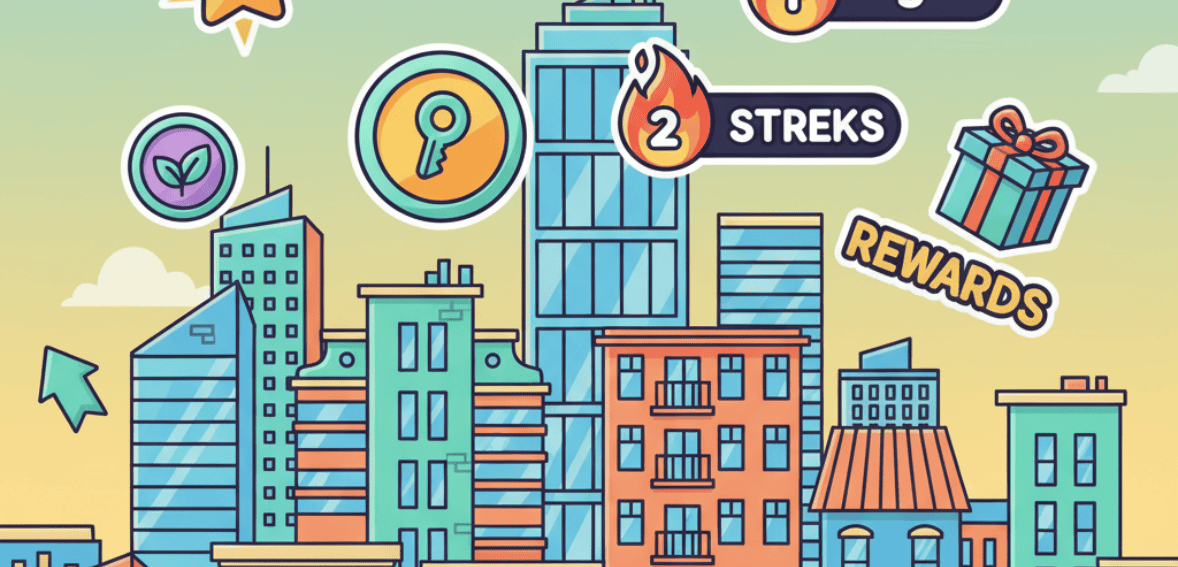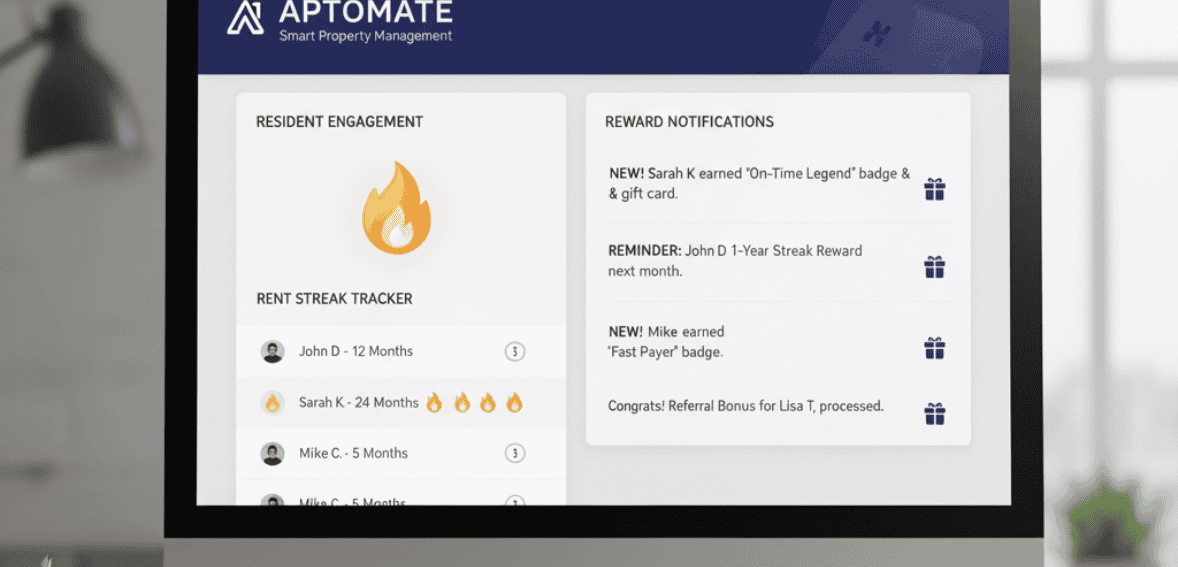
by admin November 20, 2025
Building strong relationships with tenants has always been at the center of successful property management. A good landlord knows that a smooth rental experience, consistent communication, and prompt maintenance all matter. But in today’s housing landscape where renters expect more than basic service, landlords are exploring creative ways to add value, motivation, and a sense of connection to their communities. This is where tenant engagement incentives come into play, and gamification becomes the twist that makes everything feel fresh, modern, and effective.
Gamification sounds like something for video games or entertainment apps, but the truth is that the philosophy behind it has been part of everyday life for years. When a bank offers reward points for debit card use, when an airline gives miles for every flight, when shoppers collect stamps for free coffee those are all examples of gamification. The idea is simple: people enjoy being rewarded for positive behavior, and rewards encourage them to keep doing the right things. When applied to property management, that principle becomes a powerful tool.
Many landlords struggle with inconsistent rent, rising turnover, or low tenant participation in community programs. Traditional communication alone can’t always change habits. But when you turn necessary actions like paying rent on time, renewing a lease, referring friends, or taking care of the property into something that feels rewarding and interactive, tenant participation improves naturally. And that’s precisely what gamification aims to accomplish: creating a rental experience that feels engaging, motivating, and even fun.
At its heart, gamification isn’t about making renting into a literal game. It’s about adding friendly incentives, recognition, and simple challenges that improve tenant satisfaction. When tenants feel appreciated, acknowledged, and rewarded, they respond with better behavior, stronger loyalty, and less friction. This creates a better environment for everyone, tenants feel valued, and landlords benefit from fewer vacancies, fewer disputes, and better financial outcomes.
Understanding the Concept of Gamification in Rental Communities

Gamification in property management is the process of applying game-like reward systems to real-life tenant behaviors. It transforms routine tasks like paying rent, reporting issues early, keeping the property clean, or renewing leases into opportunities for tenants to earn rewards. These rewards don’t need to be extravagant. In fact, the effectiveness of gamification comes from the psychology behind it: recognition, achievement, and the satisfaction of being rewarded for good habits.
To better understand this, think about the systems we interact with daily. When someone exercises using a fitness app, they might earn badges for consistency. Credit cards give cashback for spending. Ride-sharing apps reward frequent riders. Even streaming services highlight user “streaks.” These concepts motivate people to stay active, spend more, or stay loyal.
When landlords apply similar ideas, they signal to tenants that their positive actions matter. Paying rent on time is no longer just a requirement, it becomes an achievement. Renewing a lease becomes the equivalent of “leveling up.” Participating in building events becomes a chance to earn something extra. These small psychological motivators have a real effect on behavior.
Gamification also makes the rental environment feel more connected. Instead of landlords only interacting with tenants when something goes wrong, rewards create positive touchpoints. Tenants begin to associate their landlord with appreciation instead of complaints or requests. This shift improves communication and lowers tension, two essential ingredients in strong landlord-tenant relationships.
Creative and Effective Types of Tenant Rewards That Actually Work

The beauty of a resident rewards program is that it can be as creative or straightforward as the landlord wants. Rewards don’t need to be expensive; they need to feel meaningful. When tenants feel their efforts are noticed, even a small benefit becomes a gesture of appreciation.
A common approach is to create a points-based reward system. Tenants earn points for each on-time rent payment, which can be redeemed for small rewards later. For example, after a full year of consistent payments, tenants might receive a discount, a gift card, or a home upgrade. Another version of this is “streak rewards,” in which each consecutive month of on-time payments brings tenants closer to a special perk.
Renewal rewards are another effective tool. Lease renewals are expensive and time-consuming for landlords. Offering a one-time incentive, a small rent discount for the first month of renewal, a free deep cleaning, a smart thermostat upgrade, or new blinds can encourage good tenants to stay longer.
Referral bonuses are also powerful. When a current tenant refers to a qualified renter who signs a lease, the referring tenant receives a reward. This not only reduces marketing expenses but also helps build communities where tenants know each other.
Then there are community-based rewards, which are playful and interactive. Some landlords host friendly contests like “Best Balcony Garden,” “Cleanest Patio Area,” or “Holiday Decoration Challenge,” with winners receiving small prizes. These activities spark creativity and make the community feel alive, encouraging participation and strengthening social bonds.
The key is keeping rewards light, fair, and fun not replacing professionalism, but complementing good management practices. Rewards work best when they enhance the rental experience rather than feeling like a transaction.
Technology That Makes Tenant Reward Programs Easy and Organized

Gamification becomes significantly more effective when technology supports it. Instead of manually tracking points or streaks, landlords can use simple tools or property management software to streamline the process. Cloud Rental Manager, for example, can track on-time rent streaks automatically, based on monthly payment data. This removes guesswork and ensures fairness.
Digital platforms also allow landlords to send automated messages celebrating achievements, announcing winners, or reminding tenants about upcoming community challenges. Technology enables fast, consistent recognition, which is essential for a successful rewards system. When tenants receive timely feedback like “Congrats, you just hit 6 months of on-time payments!” it reinforces the behavior immediately.
Some platforms also offer task-based rewards, such as points for submitting maintenance reports early, responding to surveys, or attending building events. This helps landlords encourage engagement where it’s needed most.
But technology also plays a vital role in fairness and transparency. A digital system provides clear rules, equal opportunities, and automated tracking to prevent disputes. Tenants can see their progress in real time, understand how rewards work, and trust that the system treats everyone consistently.
Even landlords who prefer less technology can use simple methods like spreadsheets, automated email reminders, and monthly tenant lists to build structured reward systems. The point is consistency. With or without advanced tools, the key is ensuring that tenants always know the rules, see their progress, and feel appreciated.
Why Incentives Improve Rent Timeliness and Tenant Retention

Rewards tap into motivation but they also address efficiency issues in property management. When tenants know they can earn something for paying rent on time, they put more effort into staying consistent. Late fees alone can feel punitive, but rewards add a positive twist that encourages good habits.
Engaged tenants are also more loyal. When people feel appreciated, they are less likely to move. A well-designed tenant retention strategy costs far less than vacancy, cleaning, repairs, and advertising. A single good tenant staying an extra year can save hundreds or thousands of dollars. Small rewards like a renewal gift card or a home upgrade are often far cheaper than turnover costs.
Rewards also improve communication. Tenants who feel recognized are more likely to report issues early, respond to messages, participate in community events, and treat the property with respect. The relationship shifts from purely transactional to something more collaborative.
How Gamification Builds Community and Improves the Living Experience

One of the greatest, yet often overlooked, benefits of gamification is the sense of community it fosters. A rental property isn’t just a structure with units, it’s a place where people live their daily lives. When tenants feel like they’re part of something, even something small like a friendly challenge or a shared achievement, the environment becomes more positive and connected.
Gamification adds little sparks of interaction. Maybe two neighbors talk because they both joined the same “recycling challenge.” Maybe someone decorates their balcony because they want to enter the seasonal contest. Maybe tenants congratulate each other when streak rewards are announced. These moments of connection matter more than landlords realize.
Communities don’t grow from grand gestures, they grow from repeated, small interactions that make tenants feel seen. A simple monthly message recognizing “On-Time Payers of the Month” brings people together through shared accomplishment. Hosting a fun challenge like a “Photo of Your Pet” contest or a “Best DIY Wall Art” showcase gives tenants something to smile about.
When people feel connected to their living space, they naturally take better care of it. They become more understanding when minor issues arise. They communicate more openly. They renew more often because it feels like home, not just a temporary stop. Incentives don’t replace good service, but they amplify it by making tenants feel like they’re appreciated beyond the basics.
A landlord who invests in engagement is a landlord who invests in stability. Community doesn’t eliminate every problem, but it softens the edges of daily stress for both tenants and landlords.
Creating a Fair, Transparent, and Motivating Rewards System

Rewards only work long-term if tenants trust the system. Transparency is crucial. That means every tenant should understand how rewards are earned, how often they’re given, and how winners are chosen, especially when raffles or drawings are involved.
Fairness doesn’t just protect landlords legally; it also keeps the program fun instead of frustrating. Tenants should never feel like rewards are based on favoritism or random decisions. Using neutral, trackable criteria such as on-time rent, lease renewals, or community participation ensures everyone has equal opportunity.
This is where technology becomes incredibly useful. Cloud Rental Manager can automatically track rent payments, making it easy to see who qualifies for a streak reward. Automated reporting eliminates confusion and provides an objective system that tenants can trust. If tenants know the data comes from the platform not from someone’s memory or personal impression there’s less room for conflict.
Rules should also be simple. If they’re too complicated, tenants lose interest. If they’re too vague, tenants feel uncertain. A great rewards program feels clear, achievable, and exciting. Something like:
- Pay on time for 12 consecutive months → receive a reward.
- Refer someone who signs a lease → receive a bonus.
- Participate in monthly contests → enter a raffle.
These are straightforward, easy to explain, and easy to track. The more predictable and understandable the system is, the more tenants engage with it.
Implementing Incentives Without Overspending

Many landlords love the idea of rewards but worry that they might overspend or hurt their cash flow. But a well-designed tenant engagement incentive program doesn’t require a large budget. In fact, it often saves money in the long run by reducing turnover, improving rent collection, and increasing stability.
The key is thoughtful planning. Rewards should be valuable enough to motivate tenants, but reasonable enough to fit comfortably into the property’s financial structure. Gift cards, small discounts, or minor upgrades are often sufficient. A free ceiling fan installation for a tenant who renews might cost a landlord $150. But losing that tenant could cost four times more when factoring in vacancy loss, cleaning, advertising, and maintenance between tenants.
For raffles or competitions, landlords don’t need to offer multiple prizes; one monthly prize is usually enough. Tenants participate because the possibility of winning creates excitement.
Partnerships can also reduce costs. Local businesses may offer small discounts in exchange for exposure, and landlords can pass those perks on to tenants. Free community events like a pizza night or a simple coffee-and-donuts morning cost little but have a significant impact on satisfaction.
Gamification isn’t about spending more, it’s about spending smarter. Small rewards for the right behaviors often yield bigger returns than traditional strategies.
Gamification for Small Landlords: Simple, Personal, and Effective
A lot of people assume rewards programs are only for large apartment complexes with hundreds of tenants and big budgets. But small landlords benefit the most. With fewer tenants, it’s easier to personalize rewards, track participation, and build meaningful relationships.
A duplex landlord can hand-deliver a small thank-you note and a coffee gift card to tenants who paid on time all year. A four-unit landlord can host a friendly contest or offer tailored perks. Small landlords can even personalize rewards based on what they know about each tenant something big companies can’t do.
The effectiveness of gamification doesn’t depend on scale; it depends on consistency, appreciation, and structure. Even small gestures feel big when tenants don’t expect them.
Smaller landlords also have an advantage when setting culture. They interact directly with tenants, so recognition feels more genuine. When a landlord says, “Thanks for being such a consistent, responsible tenant,” and backs it up with a small reward, it builds genuine loyalty.
Gamification isn’t about building an app or running complex programs. It’s simply about giving tenants goals, recognizing their efforts, and adding positive reinforcement to everyday actions.
Why Gamification Is Becoming a Tenant Retention Standard
Renters today value experience. They want to feel appreciated. They choose communities where they feel recognized, respected, and connected. Traditional property management focuses heavily on systems and procedures but modern renters respond more to human connection and incentives that make their lives feel valued.
Gamification isn’t a trend, it’s becoming a new normal.
More landlords are discovering that rewards reduce stress, cut turnover, improve communication, and keep tenants engaged in the long term. They see that a small investment in appreciation generates far larger savings in retention. And most importantly, tenants view their landlord more positively, which helps avoid many common landlord-tenant disagreements.
In a competitive rental market, a rewards system becomes a differentiator. Tenants compare properties not only by square footage or amenities, but by how they feel about the people who manage the place. A landlord who adopts tenant engagement incentives builds a stronger bond, which often leads to loyalty.
Conclusion
Gamifying tenant engagement doesn’t mean turning property management into a game. It means using the psychology of rewards, recognition, and motivation to create a healthier, happier, and more productive rental environment. Whether through on-time rent incentives, renewal rewards, referral bonuses, community challenges, or small personalized gestures, landlords can transform everyday interactions into opportunities for appreciation.
When tenants feel acknowledged, they communicate better, treat the property with more care, pay rent more consistently, and stay longer. Gamification aligns the landlord’s goals with the tenant’s motivations creating a win-win relationship that strengthens the entire rental community.
With thoughtful planning, clear rules, and simple tools like Cloud Rental Manager to track progress, rewards can be implemented smoothly, fairly, and cost-effectively. Gamification isn’t about flashy prizes, it’s about building trust, connection, and consistency.
In the end, rewards don’t just boost engagement, they build communities where tenants feel proud to live and landlords feel confident in their investment.
Enhancing Tenant Experience through Technology Using platforms like portals, mobile apps, and automation tools, property managers can offer convenience, strengthen tenant relationships, and drive long-term retention. These digital tools empower tenants while streamlining operations for landlords.
FAQs
What does gamifying tenant engagement mean?
It means applying reward-based features such as points, streaks, perks, or challenges to encourage good tenant habits, such as paying rent on time or renewing leases. It makes renting feel more interactive and appreciated.
Do tenant rewards actually help retention?
Yes. When tenants feel valued and recognized, they stay longer and pay more consistently. Even small incentives can significantly improve satisfaction and reduce turnover.
What rewards work best for renters?
Simple rewards like gift cards, home upgrades, renewal bonuses, referral credits, or monthly raffles are affordable yet motivating. Thoughtful, personalized perks work exceptionally well.
Can small landlords use gamification too?
Absolutely. With fewer tenants, small landlords can personalize rewards and easily track participation with basic tools or simple software features.